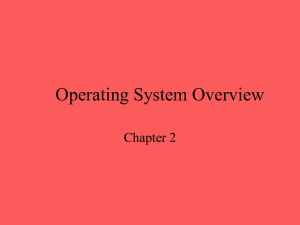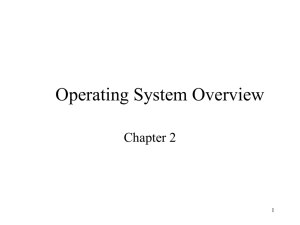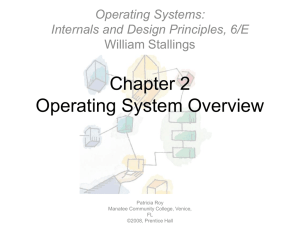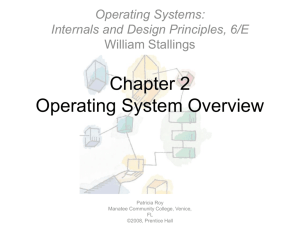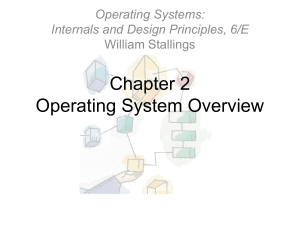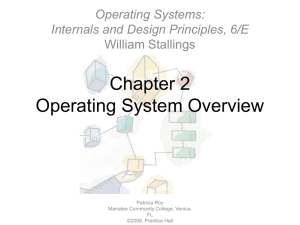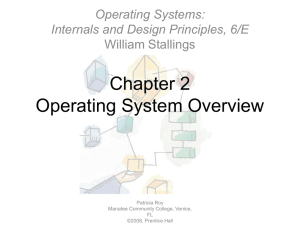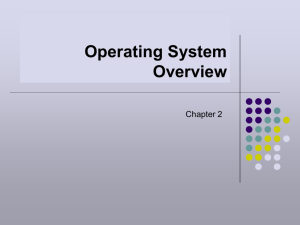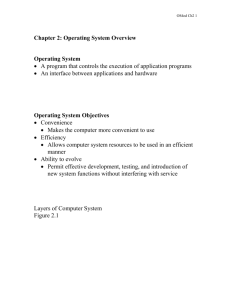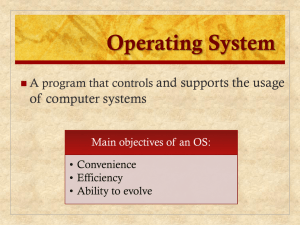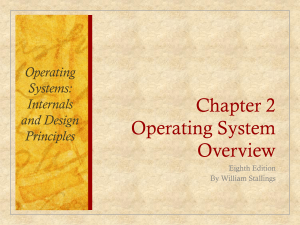Operating System Overview Operating System
advertisement
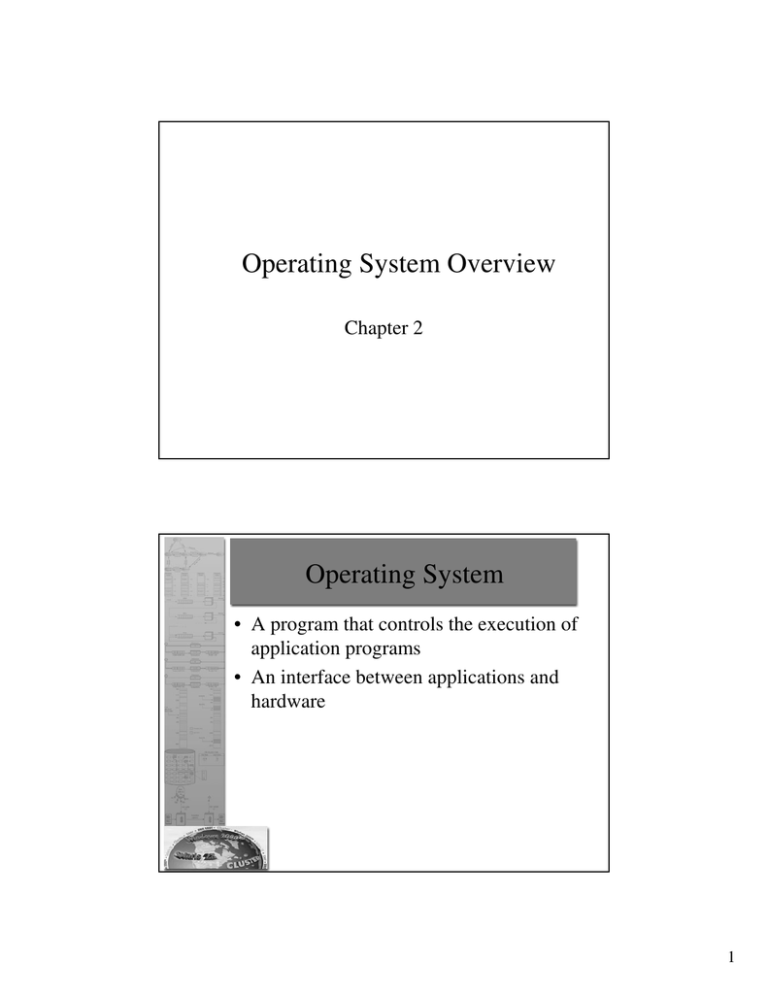
Operating System Overview Chapter 2 Operating System • A program that controls the execution of application programs • An interface between applications and hardware 1 Operating System Objectives • Convenience – Makes the computer more convenient to use • Efficiency – Allows computer system resources to be used in an efficient manner • Ability to evolve – Permit effective development, testing, and introduction of new system functions without interfering with service Layers of Computer System 2 Services Provided by the Operating System • Program development – Editors and debuggers • • • • Program execution Access to I/O devices Controlled access to files System access Services Provided by the Operating System • Error detection and response – internal and external hardware errors • memory error • device failure – software errors • arithmetic overflow • access forbidden memory locations – operating system cannot grant request of application 3 Services Provided by the Operating System • Accounting – – – – collect statistics monitor performance used to anticipate future enhancements used for billing users Operating System • Functions same way as ordinary computer software – It is program that is executed • Operating system relinquishes control of the processor to execute other programs 4 Kernel • Portion of operating system that is in main memory • Contains most-frequently used functions • Also called the nucleus 5 Evolution of an Operating System • Hardware upgrades and new types of hardware • New services • Fixes Evolution of Operating Systems • Serial Processing – No operating system – Machines run from a console with display lights and toggle switches, input device, and printer – Schedule tome – Setup included loading the compiler, source program, saving compiled program, and loading and linking 6 Evolution of Operating Systems • Simple Batch Systems – Monitors • Software that controls the running programs • Batch jobs together • Program branches back to monitor when finished • Resident monitor is in main memory and available for execution Job Control Language (JCL) • Special type of programming language • Provides instruction to the monitor – what compiler to use – what data to use 7 Hardware Features • Memory protection – do not allow the memory area containing the monitor to be altered • Timer – prevents a job from monopolizing the system Hardware Features • Privileged instructions – allowed in monitor, disallowed in user programs. e.g., all I/O • Interrupts – not in early computers 8 Uniprogramming • Processor must wait for I/O instruction to complete before preceding Multiprogramming • When one job needs to wait for I/O, the processor can switch to the other job 9 Multiprogramming Example JOB1 JOB2 JOB3 Type of job Heavy compute Heavy I/O Heavy I/O Duration 5 min. 15 min. 10 min. Memory required 50K 100 K 80 K Need disk? No No Yes Need terminal No Yes No Need printer? No No Yes Need CPU? 80% of it 10% 10% 10 Effects of Multiprogramming Uniprogramming Multiprogramming Processor use 22% 43% Memory use 30% 67% Disk use 33% 67% Printer use 33% 67% Elapsed time 30 min. 15 min. Throughput rate 6 jobs/hr 12 jobs/hr Mean response time 18 min. 10 min. 11 Time Sharing • Using multiprogramming to handle multiple interactive jobs • Processor’s time is shared among multiple users • Multiple users simultaneously access the system through terminals Batch Multiprogramming versus Time Sharing Batch Multiprogramming Principal objective Maximize processor use Job control language Source of directives commands provided with to operating system the job Time Sharing Minimize response time Commands entered at the terminal 12 Major Achievements • • • • • Processes Memory Management Information protection and security Scheduling and resource management System structure 13 Processes • A program in execution • An instance of a program running on a computer • The entity that can be assigned to and executed on a processor • A unit of activity characterized by a single sequential thread of execution, a current state, and an associated set of system resources Difficulties with Designing System Software • Improper synchronization – ensure a process waiting for an I/O device receives the signal • Failed mutual exclusion • Nondeterminate program operation – program should only depend on input to it, not relying on common memory areas • Deadlocks 14 Process • Consists of three components – An executable program – Associated data needed by the program – Execution context of the program • All information the operating system needs to manage the process Process 15 Memory Management • • • • • Process isolation Automatic allocation and management Support for modular programming Protection and access control Long-term storage Virtual Memory • Allows programmers to address memory from a logical point of view • While one process is written out to secondary store and the successor process read in there in no hiatus 16 File System • Implements long-term store • Information stored in named objects called files Paging • Allows process to be comprised of a number of fixed-size blocks, called pages • Virtual address is a page number and an offset within the page • Each page may be located any where in main memory • Real address or physical address in main memory 17 Virtual Memory Addressing 18 Information Protection and Security • Access control – regulate user access to the system • Information flow control – regulate flow of data within the system and its delivery to users • Certification – proving that access and flow control perform according to specifications Scheduling and Resource Management • Fairness – give equal and fair access to all processes • Differential responsiveness – discriminate between different classes of jobs • Efficiency – maximize throughput, minimize response time, and accommodate as many uses as possible 19 Major Elements of Operating System System Structure • View the system as a series of levels • Each level performs a related subset of functions • Each level relies on the next lower level to perform more primitive functions • This decomposes a problem into a number of more manageable subproblems 20 Operating System Design Hierarchy Level Name Objects Example Operations 13 Shell User programming environment Statements in shell language 12 User processes User processes Quit, kill, suspend, resume 11 Directories Directories Create, destroy, attach, detach, search, list 10 Devices External devices, such Open, close, as printer, displays read, write and keyboards 9 File system Files Create, destroy, open, close read, write 8 Communications Pipes Create, destroy, open. close, read, write Operating System Design Hierarchy Level Name Objects Example Operations 7 Virtual Memory Segments, pages Read, write, fetch 6 Local secondary store Blocks of data, device Read, write, allocate, free channels 5 Primitive processes Primitive process, semaphores, ready list Suspend, resume, wait, signal 21 Operating System Design Hierarchy Level Name Objects Example Operations 4 Interrupts retry programs Interrupt-handling Invoke, mask, unmask, 3 Procedures Procedures, call stack, display Mark stack, call, return 2 Instruction Set Evaluation stack, micro- Load, store, add, subtract program interpreter, branch scalar and array data 1 Electronic circuits Registers, gates, buses, etc. Clear, transfer, activate, complement Characteristics of Modern Operating Systems • Microkernel architecture – assigns only a few essential functions to the kernel • address space • interprocess communication (IPC) • basic scheduling 22 Characteristics of Modern Operating Systems • Multithreading – process is divided into threads that can run simultaneously • Thread – dispatchable unit of work – executes sequentially and is interruptable • Process is a collection of one or more threads Characteristics of Modern Operating Systems • Symmetric multiprocessing – there are multiple processors – these processors share same main memory and I/O facilities – All processors can perform the same functions 23 Characteristics of Modern Operating Systems • Distributed operating systems – provides the illusion of a single main memory and single secondary memory space – used for distributed file system Characteristics of Modern Operating Systems • Object-oriented design – used for adding modular extensions to a small kernel – enables programmers to customize an operating system without disrupting system integrity 24 Windows 2000 • Exploits the power of today’s 32-bit microprocessors • Provides full multitasking in a singleuser environment • Client/Server computing Windows 2000 Architecture • Modular structure for flexibility • Executes on a variety of hardware platforms • Supports application written for a variety of other operating system 25 OS Organization • Modified microkernel architecture – Not a pure microkernel – Many system functions outside of the microkernel run in kernel mode • Any module can be removed, upgraded, or replaced without rewriting the entire system Layered Structure • Hardware abstraction layer (HAL) – Isolates the operating system from platform-specific hardware differences • Microkernel – Most-used and most fundamental components of the operating system • Device drivers – Translate user I/O function calls into specific hardware device I/O requests 26 W2K Executive • • • • • • • • I/O manager Object manager Security reference monitor Process/thread manager Local procedure call (LPC) Facility Virtual memory manager Cache manager Windows/graphics modules User Processes • Special system support processes – Ex: logon process and the session manager • Server processes • Environment subsystems • User applications 27 Client/Server Model • Simplifies the Executive – possible to construct a variety of APIs • Improves reliability – each service runs as a separate process with its own partition of memory – clients cannot not directly access hardware • Provides a uniform means fro applications to communicate via LPC • Provides base for distributed computing Threads and SMP • Different routines can execute simultaneously on different processors • Multiple threads of execution within a single process may execute on different processors simultaneously • Server processes may use multiple threads • Share data and resources between process 28 UNIX • Hardware is surrounded by the operating-system • Operating system is called the kernel • Comes with a number of user services and interfaces – shell – C compiler 29 UNIX Modern UNIX Systems • • • • System V Release 4 (SVR4) Solaris 2.x 4.4BSD Linux 30
